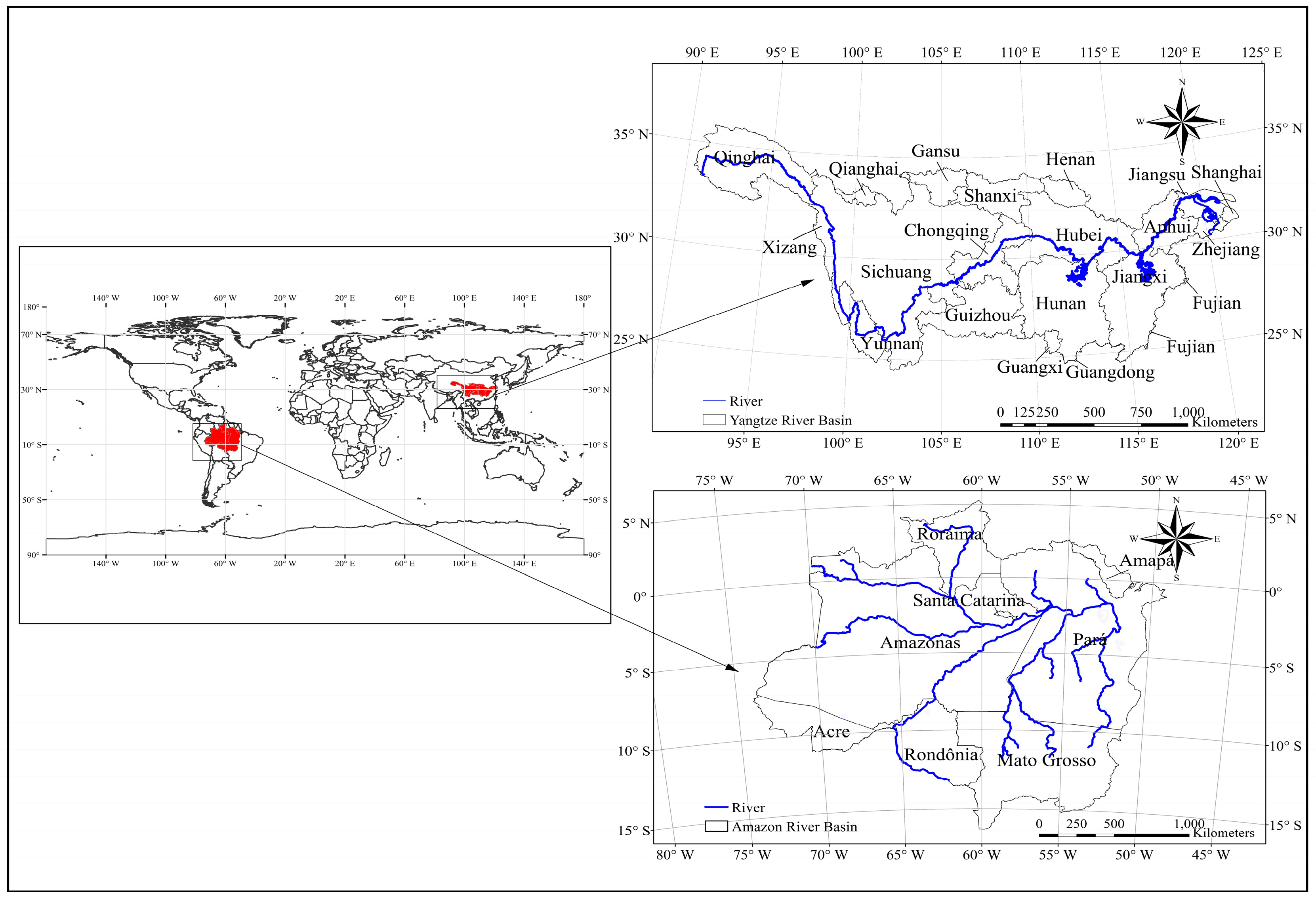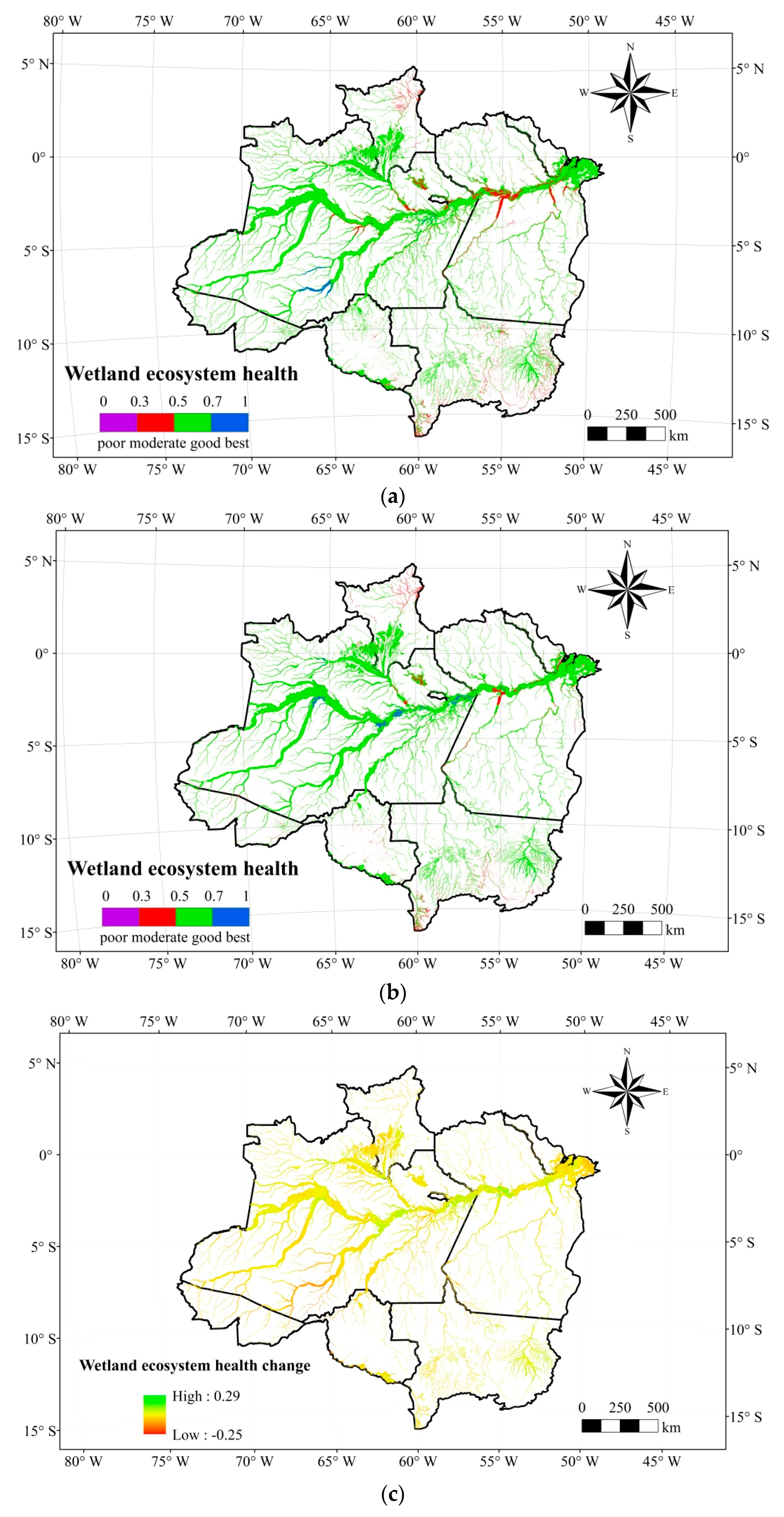2.1. Study Area
The study area includes the Yangtze River Basin in China and the Amazon River Basin in Brazil (
Figure 1). The Yangtze River Basin is the third largest river basin in the world, with a total area of 1,800,000 km
2. It is in multistage ladder terrain, flowing through the Qinghai-Tibetan Plateau, Hengduan Mountains, Sichuan Basin, and the middle-lower portion of the Yangtze plain. The climate in the basin is a typical subtropical monsoon climate, making it hot and rainy in the summer and warm and humid in the winter. The annual average rainfall is 1067 mm, decreasing from southeast to northwest. The Yangtze River flows through 19 provinces in China, and the basin includes the whole area of Sichuan, Chongqing, Hubei, Hunan, and Jiangxi provinces and part of the area of Qinghai, Xizang, Gansu, Shanxi, Yunnan, Guizhou, Guangxi, Guangdong, Henan, Anhui, Jiangsu, Shanghai, Fujian, and Zhejiang provinces. There are approximately 400 million people in the Yangtze River Basin, accounting for one-third of the Chinese population. The average population density is more than 220 people·km
−2, and with its rapid economic development, the per capita gross domestic product (GDP) in the Yangtze River Basin was more than $3000 in 2010.
The Amazon River is 6400 km in length, making it the second longest river in the world. The Amazon River Basin (6° N–20° S, 79° W–48° W) is located in the northern part of South America, has an area of 6,915,000 km2, and flows through Peru, Brazil, Bolivia, Ecuador, Columbia, Venezuela, and other countries. The area of the Amazon River Basin makes it the largest basin in the world. Approximately 2/3 of the basin, an area of 3,900,000 km2, is in Brazil. The Amazon River Basin has plenty of water throughout the year; the average annual flow is 220,000 m3s−1 at the mouth, and during the flood period it is up to 280,000 m3s−1. Most parts of the basin have a tropical rain forest climate, meaning it is warm, humid, and rainy. The average annual rainfall in the Amazon River Basin is 2000 mm or more. The Amazon’s tropical rainforest accounts for 1/3 of the total tropical rainforests in the world. The Amazon River Basin in Brazil includes the whole area of Acre, Amazonas, Santa Catarina, Rondônia, and Roraima states and part of the area of Amapá, Mato Grosso, and Pará states. The average population density is less than 10 people·km−2, and the per capita GDP in the Amazon River Basin in Brazil was more than $10,000 in 2010.
Wetlands in both the Amazon and Yangtze River Basins are largely affected by human activities. Since the 1950s, approximately 1100 km
2 of the intertidal land in the Yangtze River Delta has been embanked, resulting in the disappearance of saltmarshes and even the entire intertidal zone along some sections of the coastline [
24]. Using satellite images, the latest analysis of the Amazon River Basin found that an average of 15,550 km
2 of forest has been selectively cut down. Selective cutting intensifies erosion processes [
25] and directly or indirectly affects the health of wetlands in river basins. Part of Brazil’s Pantanal wetland, the world’s largest wetland, is in the southwest of the Amazon River Basin. In recent years, nearly 99% of Pantanal land has been occupied by human beings and has been used particularly for farmland and pasture. Therefore, the protection of Pantanal land has become an imminent problem. The Pantanal wetland ecosystem is facing a crisis caused by human activity, including unregulated fishing, hunting, endangered species smuggling (e.g., alligators, leopards, lynx, and parrots), unregulated tourism activities, and deforestation [
26].
2.2. Selection of Indicators
According to the PSR model, the indicators can be divided into three categories: pressure, state, and response. Taking into account the data availability, we chose 13 ecosystem indicators in total to establish the wetland ecosystem health evaluation model. Details of these indicators are shown in
Table 1.
The pressure factors include indirect pressure (such as human activities) and direct pressure (such as resource utilization and pollution emission). Pressure is a measure of the intensity of wetland utilization and the rate of change in wetland resources within a particular period. Human economic activities play a much greater role in wetland change. This pressure is caused by the population density, GDP, urbanization rate, and pressure of cultivated land. Jiang et al. [
3] and Jia et al. [
27] have indicated that it is reasonable to assume that greater population densities increase the negative impact to the health of wetlands. Jiang et al. [
21] and Jia et al. [
27] used GDP data to evaluate the health conditions of their study area. Therefore, in this paper, we chose population density and GDP to indicate ecosystem pressure. The urbanization rate and pressure of cultivated land were selected based on previous studies [
28]. The urbanization rate is calculated as the ratio of artificial land area to the total area. The pressure of cultivated land is calculated as the ratio of cultivated land to the total area.
The state factors indicate the current situation of the ecological system and natural environment, which were used to describe the structure of the wetland ecosystem composition and the function of the wetland under pressure. Water state transformation and movement are the most important processes in wetland ecosystems, which are determined by the landscape, flooding, rainfall, and evaporation. Therefore, we chose the average annual rainfall [
29,
30], net primary productivity (NPP) [
31], and terrain slope to evaluate the state of wetland ecosystem health [
32]. Because a landscape index can be used to convey pattern information about wetland landscapes [
33,
34] and the landscape metrics are sensitive to scale [
35], we chose patch density, perimeter area fractal dimension, Shannon’s diversity index, and the contagion index to quantify the state of wetland ecosystem health [
36]. We obtained these landscape indices from GlobeLand30, added the areas of wetland and water as the total wetland area, and then used the landscape index formula through Fragstats 4.4.
Human pressure can cause changes in wetland environments and natural resources, which were used as the response indicators. The proportion of wetland area and the ecosystem services value were chosen as the response indicators. We obtained the wetland area from GlobeLand30, and the ecosystem services value was calculated using the coefficient of ecosystem services value from Costanza [
37].
2.3. Data and Pre-Processing
We used raster and socio-economic data to evaluate wetland ecosystem health. The raster data included the GlobeLand30 land cover map [
22], net primary productivity (NPP), a digital elevation model (DEM), and rainfall data. The GlobeLand30 land cover map at 30 m was produced from 10,000 Landsat-like satellite images based on the integration of pixel- and object-based methods with knowledge (POK-based) [
22]. A split-and-merge strategy was employed to handle the classification process of land cover types [
22]. In this study, we choose the GlobeLand30 land cover map for the years 2000 and 2010. The land cover types of GlobeLand30 include cropland, forest, grass, shrub, wetland, water, artificial cover, bare cover, and permanent ice or snow.
The land cover maps were resampled at 1 km resolution by calculating the proportion of each land cover type within each 1 km grid cell. We processed the GlobeLand30 land cover using the following method: first, we determined the ratio statistics of different land cover types at 30 m resolution in a 1 km grid; then, we resampled the 30 m resolution data to 1 km resolution and extracted the land types from the resampled data, including croplands, forest, grass, artificial cover, water, and wetlands. The 1 km resolution MODIS NPP data were downloaded from the website
https://ladsweb.nascom.nasa.gov/data/search.html. The 1 km resolution DEM data were obtained from
http://www.gscloud.cn/. The average annual rainfall data between 2000 and 2010 were obtained from the global weather data databases for SWAT (Soil and Water Assessment Tool) data sharing platforms (
http://globalweather.tamu.edu).
The socio-economic data included population and GDP. The gridded population and GDP data in the Yangtze River Basin were downloaded from the website
http://www.geodata.cn. The population of the Yangtze River Basin was divided into 1 km grid cells according to the linear relationship between population and croplands, forest, grass, and urban and rural areas [
38,
39,
40]. The GDP grid was also based on the relationship between GDP and land cover, including croplands, forest, grass, and artificial cover, and was disaggregated into a 1 km grid based on the methods in Liu et al. [
41]. In the Amazon River Basin, the population density grid data were downloaded from the website
http://beta.sedac.ciesin.columbia.edu/data/collection/gpw-v4/sets/browse. We disaggregated the GDP data into a 1 km grid based on the relationship between GDP and land cover, including croplands, forest, grass and artificial cover in the Amazon River Basin.
Because the indicators differ in units and dimensionality, we used a linear scale transformation of the max–min method [
42] to normalize the data and scale the value of all indicators from 0 to 1.









